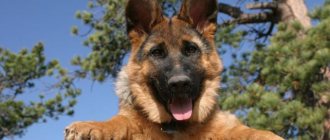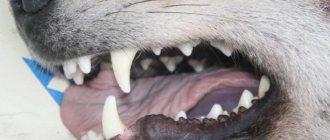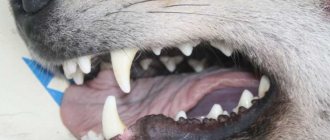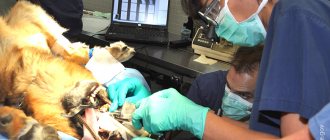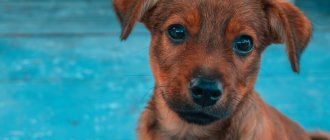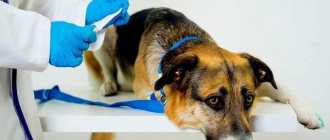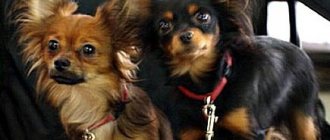Just like in children, dogs change their milk teeth to permanent teeth, with only one difference - by the age of one year the puppy turns into an adult dog. Most physiological processes, including the change of teeth in dogs, proceed at an accelerated rate.
Dog puppies are born with no teeth in the mouth - with bare gums - and by adulthood they have 42 permanent teeth.
During their lifetime, dogs have two sets of teeth - milk and permanent. Moreover, regardless of the dog’s breed, the replacement of milk teeth with permanent ones occurs in the same sequence; the only difference is in the timing of the change of teeth. There is such a pattern - in dogs of large breeds, unlike dogs of small breeds, the change of milk teeth to permanent teeth occurs faster.
Milk teeth in puppies
Puppies are born with missing teeth. They feed exclusively on mother's milk. The first milk teeth in puppies begin to appear 20-30 days after birth.
At the same time, in dogs of dwarf and decorative breeds, the first milk teeth appear at 1.5 months of age. With proper jaw development, puppies should have 28 primary teeth (14 teeth on the lower jaw and 14 teeth on the upper jaw). Of the milk teeth there are 4 canines, 12 incisors and 12 molars. The canines begin to appear first, then the incisors, and lastly the molars.
Types of teeth
Dogs have three types of teeth, each with a specific function.
Fangs
Fangs are fairly long teeth. They are located directly between the incisors and premolar teeth. There are four of them, two on top and bottom, one on the right and on the left.
Permanent teeth
After the canines come the premolars. There are four of them on all sides. They are found on all jaws. Behind them the molars continue. There are molars on all sides.
Incisors
There should be six of these chewing devices on all the dog’s jaws. To the right and left of the special vertical straight line, which divides the pet’s entire jaw into two halves, there are hooks. Next come the middle ones, and then the edges.
Permanent teeth in dogs
When the puppy reaches the age of 4-6 months, the dog’s milk teeth, like those of children, begin to change to permanent teeth. The replacement of baby teeth with permanent ones usually lasts two months and depends on the breed of the dog. At the same time, the number of permanent teeth that appear exceeds the number of milk teeth; the dog has 42 of them. All permanent teeth are divided equally into the upper and lower jaws, with the exception of molars, of which there are two more in the lower jaw.
The change of teeth in dogs is due to the fact that the rather long root of a baby tooth gradually dissolves, becomes weak and is pushed out by a strong, growing permanent tooth.
The first of the dog's permanent teeth to appear is the incisors, then at five months the molars (molars and premolars) appear; the last of the dog's permanent teeth to appear are the canines, first on the lower and then on the upper jaw. The complete replacement of milk teeth in dogs should be completed by the first year of life (up to 9 months in large breeds and 10-11 months in small breeds of dogs).
By this time, the dog does not have a single baby tooth. Usually, the replacement of baby teeth with permanent teeth in dogs is painless and easy.
Sometimes, especially in small and short-faced breeds of dogs, a permanent tooth grows next to the baby tooth. Experts explain this phenomenon by the fact that the dog has poorly developed chewing muscles, especially when puppies eat soft food, as well as a decrease in the size of the gums.
In dogs of large breeds - Great Danes, Rottweilers, Mastiffs - there are additional incisors. Experts consider this a variant of the norm.
Any disruption in the replacement of baby teeth with permanent teeth negatively affects the formation of the upper and lower jaws and the dog’s bite. Therefore, all baby teeth that fall out at the wrong time must be removed at a veterinary clinic. During the removal of milk teeth, space for permanent teeth is made in a timely manner, as a result the dog will develop a correct bite.
In order for the process of changing teeth to proceed correctly, the puppy needs proper feeding and vitamins (feeding puppies, vitamins for dogs).
Dog's dental system
For any breed of dog, the dental system plays an extremely important role in the body, since the quality of life and health of the pet depends on it. These are very durable bone tissue formations that perform important functions:
- attacks;
- protection;
- capture;
- retention;
- tearing and crushing food;
- killing prey.
The dental chart is written with a special formula, which indicates the number of dental units of an adult animal on one half of each jaw.
On the top there is:
- 3 incisors;
- 1 fang;
- 4 premolars;
- 2 molars.
On the bottom:
- 3 incisors;
- 1 fang;
- 4 premolars;
- 3 molars.
The dental formula is written in alphabetic and numerical combinations, describing the location of the teeth in the animal’s mouth. The tooth consists of an upper crown that stands out above the gum. Its slightly narrowed neck is tightly covered by the gum. The dental root hidden in the alveolus has a small hole in the upper part leading into the cavity of the dental unit. Inside it is a soft pulp in which blood vessels and nerves are located. The main part consists of dentin. The outside is covered with hard tooth enamel. The tooth is located on the periosteum, which is called periodontium.
Photo: wikimedia.org Dog teeth: 1, 2, 3 - incisors, 4 - canines, 5 - premolars, 6 - molars
Why do you need to know when dogs change their milk teeth to permanent ones?
Experts have proven that the process of changing teeth in dogs affects the animal’s immune system, which at a given period of time is experiencing disruptions in the dog’s body. The dog becomes less resistant to various adverse environmental factors, infectious and parasitic diseases. At this time, veterinary experts do not recommend vaccinating dogs against certain infectious diseases common in the region of residence. These repeated vaccinations are postponed to the time when the dog has completed the replacement of milk teeth with permanent teeth. In order to reduce the risk of the puppy contracting one or another infectious disease, dog owners must complete all vaccinations before changing teeth.
If the number of teeth is not normal
Healthy teeth are the key to a dog’s life expectancy. With normal animal care, they can wear off, but will not fall out. A healthy dog's teeth are more durable and hard. If an animal begins to have problems with its teeth, it means it is sick.
It is difficult for the owner himself to determine why the dog’s teeth are falling out; only a veterinarian can tell you what to do in such a situation after examination and checking the tests. The sooner the animal owner contacts specialists, the greater the chance of eliminating the dangerous symptoms of diseases expressed in the destruction and loss of permanent teeth.
Tooth loss can be the result of an injury received while playing with other animals or the owner, as well as in a number of other cases.
Photo: wikimedia.org
Signs of a healthy grin in a dog
By the end of the first year of life, dogs develop a strong, healthy and permanent grin of 42 teeth. A deviation in the number of teeth, both smaller and larger, indicates a violation of the puppy’s intrauterine development or is a consequence of mutations at the genetic level.
The color of the tooth enamel changes from white to slightly yellow during the dog’s life.
The angle of growth of the teeth and the contact of the upper and lower jaws (bite) are different in different breeds of dogs. Deviation from the normal arrangement of teeth among specialists has its own name.
As dogs age, tooth crowns wear down and canines wear down. If the dog has a normal bite, tooth wear occurs evenly and does not affect food intake.
On a note
It is important to take care of your pet’s oral cavity from an early age, teaching him to examine his mouth and brush his teeth 1-2 times a week. For cleaning, use a special paste and a brush.
It is recommended to select healthy treats and safe, age-appropriate toys that help clean the enamel surface.
Similar articles:
- Do Dogs Feel Guilt and Shame?
- Dogs that look like wolves
- Injections for estrus in dogs
- Change of dog owner
- How to determine a dog's age
- Dog Breed Sizes
How does changing teeth affect a puppy's health?
Teething in puppies is usually painless for them. Puppies, like a child, when he is teething, in order to relieve the itching in his gums, drag various toys into the oral cavity or gnaw everything around him. To relieve itching, pet stores sell special toys or tendon bones.
In some cases, when the first teeth appear, there may be a slight increase in body temperature, lethargy, decreased appetite (loss of appetite in the dog) and, as an exception, diarrhea.
Teething order
When a dog begins to change teeth, its owner needs to monitor this process. Therefore, the mouth must be examined every day. The order of eruption varies among breeds.
In representatives of large breeds, this process goes faster, and problems with grinning rarely occur. Regular examination allows you to see which teeth will fall out.
Owners of large breed dogs can pull out a loose tooth themselves. To do this, you need to loosen it and tear it out using a clean gauze napkin. There will be no problems, because the roots of the baby teeth have practically dissolved by the time of the change.
In dogs of medium and small decorative breeds, for example, Chihuahuas or Yorkies, spaniels, corgis, poodles, this process is accompanied by difficulties. They are predisposed to problems with their teeth. Most often they have a “second row”. Therefore, their owners often turn to veterinarians for help. They also have to carefully monitor the puppy’s nutrition.
Types of bite in dogs
Not only its exterior, but also the animal’s health depends on the position in which the dog’s upper and lower jaws are in relation to each other. As a result of an incorrect bite, a dog can develop diseases of the digestive system, respiratory system, and sometimes the heart.
Main types of bite:
Normal or scissor.
In the process of evolution, wild dogs were forced to hunt other animals to feed themselves, as a result of which the structure of the jaws of dogs was designed to grab and hold prey. Therefore, for most dog breeds this bite is considered normal. With this type of jaw bite, the upper and lower jaws are equally developed. The front surface of the lower incisors is tightly adjacent to the back surface of the upper ones, the dog’s canines converge in a “lock”, the lower incisors rest against the base of the upper incisors. This type of bite is considered the norm for dogs - German and Caucasian, Doberman Pinschers, Pinschers, Terriers. Dogs with this type of malocclusion have less wear on their teeth, and owners of these breeds are less likely to go to the veterinary clinic with dental problems.
Pincer or level bite.
The position of the jaws in a straight bite is considered unacceptable for most dog breeds. Experts still classify this type of bite as a not too serious defect. With a pincer bite, the dog's upper and lower incisors are located on the same line and rest against each other, as a result of which the dog's teeth quickly wear down. This jaw position is considered unacceptable for most dog breeds. However, a pincer bite is still considered a not too serious defect. In this case, the dog’s lower and upper incisors are located on the same line and rest against each other, because of this they grind down very quickly. At the same time, a direct bite in dogs usually does not have a negative effect on the canines and molars. This type of bite in dogs can be either congenital or acquired. This type of bite in a puppy can be formed by the owners of the animal themselves as a result of too active games of tugging with the help of toys.
Underbite.
With an underbite, the dog's lower jaw is underdeveloped. Because of this, the dog has free space between the incisors. The lower canines are loosely adjacent to the edges of the upper jaw. An underbite in a dog can cause certain dental diseases. When a dog has an underbite, a large load falls on the molars and canines; in this case, they adjoin each other very tightly. With underbite in dogs, tartar often forms (treatment and prevention of tartar formation in dogs).
Undershot or bulldog-shaped.
An undershot is not a defect and is considered normal for bulldogs, Pekingese, and bull terriers. When overbiting, the dog's lower incisors protrude in front of the upper incisors. The dog's lower jaw protrudes forward. When a dog bites, the incisors and canines may even be exposed.
When to contact a veterinarian
Frequent dog diseases that, unfortunately, cannot be dealt with on your own:
- Stomatitis is a problem with the oral mucosa.
- Caries is a disease of tooth enamel.
- Periodontitis is a disease of the tissues directly around the tooth.
- Tartar is the appearance of hard plaque on the teeth.
- Pulpitis is the presence of a large amount of pus directly in the root canal.
The dog's teeth break regularly. This happens due to a deficiency of beneficial microelements or vitamins in the diet, injury or severe pressure.
Gingivitis is inflammation of the gums. This disease causes many problems - the dog constantly whines and is unable to eat.
Another problem that requires veterinary help is malocclusion. It may occur due to abnormal development of the denticles.
Gum inflammation in dogs
Often a minor inflammatory process of the gums accompanies the entire period of changing teeth in a puppy. Clinically, this process in a puppy is manifested by redness and swelling of the gums, severe drooling, decreased appetite and the development of stomatitis (stomatitis in dogs).
Delayed tooth replacement or “stuck” baby teeth.
Sometimes a puppy’s baby teeth don’t have time to fall out before permanent ones “make their way” into their place. In addition to malocclusion, persistent teeth are dangerous due to additional injuries to the cheeks and inflammation of the gums. When examining the oral cavity, puppy owners discover baby teeth in the jaw at an age when they should no longer exist, as well as two processes from one tooth socket, one of which is baby teeth.
In the event that a dog owner cannot remove a loose tooth himself, it is necessary to contact a veterinary clinic about this problem.
Helping a puppy through a difficult period
When dogs change teeth, their immunity decreases. For the entire period, it is recommended to protect your pet from stress, intense physical activity, contact with other animals and vaccinations. You should also review your current diet, strengthen oral hygiene measures, and purchase teethers.
Gnawing accessories
A teether is a special device filled with water. Keep it in the refrigerator before use, as the low temperature reduces itching and inflammation. Using a teether, a regular rubber toy, or chewable treats can prevent damage to furniture and valuables.
Please note that it is better to remove dangerous objects away during this period. A baby suffering from itching may accidentally bite the wire and get an electric shock.
Oral hygiene
Regular oral hygiene protects against stomatitis, caries, tartar and other dental diseases. Your baby needs to be taught to brush his teeth to avoid problems in the future.
To clean the enamel, you need to purchase a special toothbrush, veterinary paste or cleaning gel. Move strictly from top to bottom from the outside of the jaw towards the inside.
The procedure should be repeated 5-10 times a month, and every 2 months the pet should be examined at a veterinary clinic. This way you can easily understand whether your dog has baby teeth, or whether the process of replacing them with molars has already come to an end.
Feeding
To form a beautiful and healthy bite, your puppy will need a lot of calcium and phosphorus. When feeding natural foods, be sure to include in your diet:
- veal;
- raw carrots;
- sea fish and fish oil;
- fermented milk products (cottage cheese, cheeses, kefir);
- beef liver;
- spongy bones and boiled cartilage;
- sea buckthorn oil.
The addition of ready-made vitamin and mineral complexes should be discussed with your veterinarian. Otherwise, you risk causing an overabundance of vitamins.
If your pet eats dry food, then it already contains all the necessary elements. All you have to do is focus on the baby’s well-being, combining granules and wet canned food. The former will help relieve itching, and the latter will help reduce the sensitivity of inflamed gums.
Caring for your dog’s teeth during the period of changing milk teeth to permanent ones
During the teething period, dog owners must carefully ensure that permanent teeth do not begin to grow until the baby teeth fall out. Do not play games with puppies that are aimed at tearing toys and other objects out of the mouth by force; there is a high risk of loosening baby teeth and disrupting the bite. If possible, inspect your puppy's mouth regularly. If baby teeth do not fall out on time, consult a veterinarian (examination of the dog by a doctor). In dwarf dog breeds, you can carefully loosen baby teeth yourself. To avoid injury to the gums, do not let your puppy chew on anything very hard.
Possible complications
Dwarf breeds have the hardest time with the change of baby teeth. If your pet is at risk, examine its oral cavity every day so as not to miss warning signs of complications.
Gum inflammation
Accompanied by redness and swelling of the mucous membranes, as well as profuse salivation, which worsens the appearance of the fur on the chest. This complication usually goes away on its own, but sometimes develops into periodontal disease. It can be identified by severe bleeding of the gums and a strong odor from the mouth.
Stuck teeth
Some animals retain 2 rows of teeth at once. This complication is called persistence. It is fraught with increased trauma to the mucous membranes and cheeks, as well as malocclusion.
Be sure to check if your dog has baby teeth next to his molars. If you find two shoots in one hole, contact your veterinarian. Sometimes the problem can be solved by manual loosening, but in most cases surgery cannot be avoided.
Malocclusion
Improper closing of the jaws is typical for breeds with an elongated muzzle: dachshunds, labradors, dobermans, rottweilers. It is facilitated by games of tug of war, feeding exclusively soft food and persistence.
To correct the bite, rubber corrector rings are used that act as braces. If the animal is not a show animal, then it is enough to prevent the situation from worsening and control the position of the jaws.
Malfunctions of the gastrointestinal tract
Quite often, babies experience diarrhea. It is not dangerous, as the stool quickly returns to normal. You should only worry if you experience symptoms of dehydration:
- dry mucous membranes, nose and coat;
- loss of activity and increasing lethargy;
- slow smoothing of skin crumpled into a fold by fingers.
Additionally, vomiting and fever may occur. A pet with such symptoms must be shown to a veterinarian within the first day after their discovery. Otherwise, he may die.
What can you chew to relieve itchy gums?
In nature, puppies chew branches and sticks for this purpose. If possible, you can bring them home. There are also a number of things that will help solve this problem:
- toys made of durable material (it is advisable to change them after a few days so that the puppy does not lose interest in them);
- teethers;
- healthy treats;
- large articular bones;
- vegetables and fruits;
- wood, preferable to fruit trees.
If the puppy does not have things that he can chew, then he will begin to damage furniture, shoes and other valuables. This can also be made part of training, teaching your pet to chew on certain objects.
